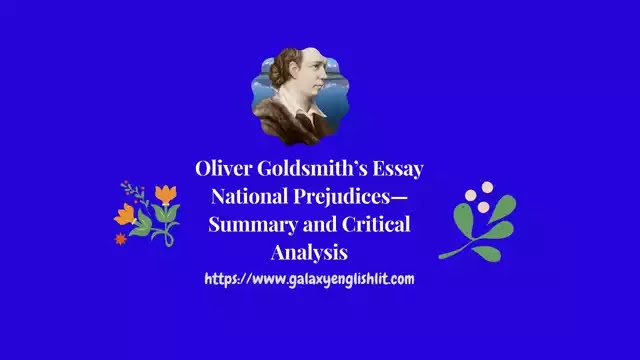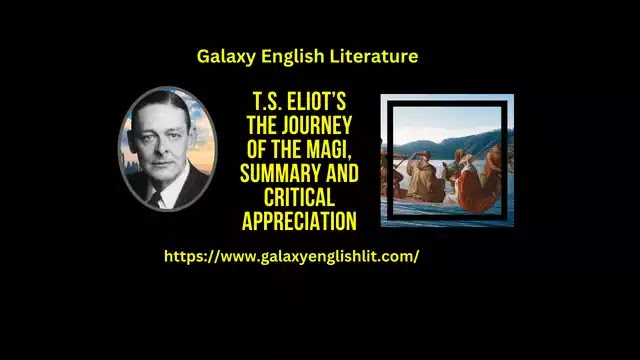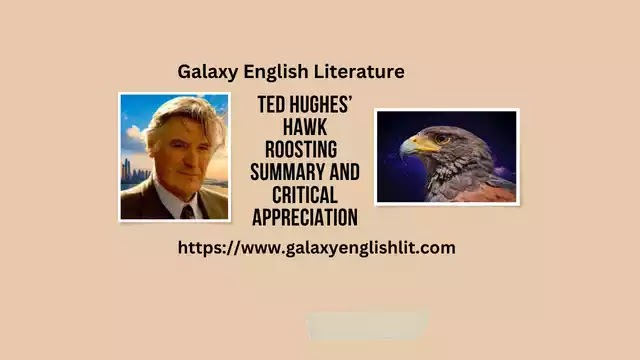A Wide Range of Animals Depicted in Poems:
Hughes uses animals, fish and birds as aesthetic shapes and sources of life to combat the sterility of his times. Animals are poetic masks and powerful poetic symbols for Hughes, to reach the world of the spirit. The animals, fish and birds mentioned by Hughes in his poems cover a wide range. The hawk, the thrush, the pike, the jaguar, the skylark, the horse, the cat, the mouse, the bull, the pig, the otter, the bullfrog and there are several other figures which get place in his poems.
 |
| Animals, Dominant Themes in Ted Hughes’ Poetry |
Hughes’ treatment of the animal is different. It is highly poetic, fanciful, symbolic, significant, expressive, illuminating and modern both on content and style. His employment of metaphors has concern with a particular animal to all the other creatures and also to human experiences and human concepts.
Hawk:
In the poem Hawk Roosting, the hawk is to be imagined as speaking and expressing his ideas about itself and the universe of which it is a denizen. The hawk speaks with a sense of authority. Its egoism is boundless and infinite. It is proud of its power to kill. It reminds us of the pike in another poem by Hughes. All the fierceness and brutality of the hawk have been summed up in a few lines: “I kill where I please because it is all mine.” The hawk's whole business in life is to tear off heads. “Its whole concern is to distribute death and it never wavers in carrying out this task because it knows only one path, and that is the path leading it directly through the bones of the living creatures.”
Pike, a Kind of Fish:
In the poem Pike, pike is a voracious, fast moving fresh water game fish. The poet addresses these fishes as “killers of submarine delicacy and horror that were reared in a fish tank. He sadly describes how three pikes were reduced to two and then from two to one. Theirs was a fight unto death for survival in the line “And indeed they spare nobody.” Pike is a complete and powerful poem. It sets fish and fisherman in a natural setting. These fresh water fishes are voracious, slender, game fish with sharp teeth. The first two stanzas describe these traits of the pike. They describe the features and movements of this killer fish with its “malevolent aged grim”, “of submarine delicacy and horror.” Here, one thinks of the human world of war and destruction. Again, how a pike lies in wait at its unwary prey under the gloom of the lily - pads is described very dramatically in the next two stanzas. Indeed we sense a shiver in our spine of the brutal killer instinct of this unscrupulous fish when we read “and indeed, they spare nobody.” Towards the end, the poem moves into the scene of an old monastery with a lily pond “as deep as England.” The pond held Pike “too immense to stir”, probably here is the analogy to the political scene of killers in England indicating the fear of the poet in the words “with the hair frozen on my head.”
Crow:
The poem entitled Crow Alights, tells us about the coming of crow on earth from deep space and as it comes down, it looks at different objects on the earth. It finds that the earth is composed of entirely living things like the mountain herds, like cows, the sea encircling the land like a serpent, the stars casting their baleful influences on the world like mushrooms broadcasting their invisible spores upon the air; sparks from the fire of God or viruses from his diseased body. The crow then alights and sees what man has done to man or to himself. Man is no more than a disconnected electric machine. He has become as absurd and redundant as shoe without a sole. The crow cannot believe its eyes. Its response to this situation is simple to blink and stare.
The statements in the poem are based on the bird's eye - view of the human world and a picture of modern man, proud of his achievements but totally alienated from communion with his race and from the world which be seems to dominate. An objective on - looker on this alienated man and the universe is naturally unwanted. But that does not deter the crow from presenting a vivid picture of the self-made human condition.
Horses:
The poem entitled Horses, deals horses which are generally non - violent and devoted to men who rear them. They are famous for their fidelity to their masters. The poem tells us about the behaviours of the horses in a cold and frosty winter day. It also describes very beautifully a desolate scene in the early morning of winter day. The title of the poem naturally makes us think about the particular importance of the horses. Of course, there seems to be no element of symbol here. It is only the extra ordinary stillness and silence of the scene of nature, and then of the horses, which has been pinpointed. In most of the animal poems, Hughes depicts the wildness, the fierceness, and the brutality of the animal concerned. A horse can also be wild, and even fierce, at times. But the ten horses in this poem stand silent and still, without making any move, and without even snorting or jerking their heads. It is the passivity of the horses which is the focus of the poet's attentions. Perhaps it is the intensity of the cold which has turned these energetic and robust animals into silent, motionless, and quiescent beings.
Thrushes:
In the poem entitled Thrushes, a thrush, too, is a predatory creature. It is one of the British and general European birds. The thrushes sit on the lawn. They look like a steel coil. They have deadly eyes but delicate legs. The poet wonders at the secret of their single - minded devotion to attack their prey which is necessary for their survival. The poet contrasts a thrush with a man and regrets that man lacks the single - mindedness of thrush. The poem is basically a poem on man's nature, as there exists a dualism in man. It goes beyond the simple description of predatory. Birds and their habits and it becomes more or less a poem about man. The poet expresses a conscious respect for the bird's single minded aim and ironically condemns man for his distracted, unheroic traits of character.
Jaguar:
In the poem entitled The Jaguar, the poet describes the violent and ferocious animal. The other animals like the apes, parrots, tiger and lion, the boa constrictor and others, are either content with their condition or they seem to revolt against it helplessly, but there is a different situation in an around the cage of the Jaguar. It is surrounded, by a huge crowd as though the on - lookers were hypnotised by the Jaguar's ferocious eyes. The crowd feels attracted towards the Jaguar's cage just as a child follows a dream. The Jaguar appears ferocious and enraged. It is not enraged because of the boredom it feels. It is not angry either at the crowd or at the cage. In fact, it is quite unaware of the existence of both, though it continues to drill its feet in a motion. It so seems as if the whole world were rolling under the thrust of its heel. The Jaguar is, in fact, like a visionary who cannot be bound by the smallness of his prison cell. The visionary's mind is in the horizon beyond the cell, and so it is with the Jaguar. The poem, thus, goes beyond a simple description of a Jaguar in a zoo. The Jaguar, no longer remains an animal, but becomes a representative of man in certain respects. The encounter between the civilized man and the primitive barbarous beast is held by the poem in a dialectical tension. The civilised man is after all a fallen creature and is so mesmerized by the superior power of energy that is both inside and outside him. The Jaguar is above all an energetic being exploding beyond the bars of its case.
The Fox:
In the poem The Thought Fox, the fox is the poetic energy or inspiration that comes out of darkness or figuratively from the unconscious mind of the poet. This inspiration leaves its footprints on snow, figuratively on the white blank page. The imaginary fox is the symbol of the inspiration for writing poetry. It moves like a fox touching the twigs and leaves with its nose. What the speaker sees, are two eyes that move in the darkness and leave their footprints on the snow. Then a lame, cautious body in the form of an eye comes brilliantly and cautiously towards the room. With the stink of a fox it enters the hole of the speaker's head.
The Bull:
In the poem entitled The Bull Moses, the bull seems to the speaker to belong to another world, beyond the world of human consciousness. In fact, the bull seems to stand at the meeting - point of the two worlds. There was a time when the bulls were not tamed by any power, but now the farmer leads the bull to the pond to drink and to smell the air. Now the bull has to follow the command of the farmer. It has to submit to a life of servitude. The bull, which in this poem has the name moses resembles a visionary or dreamer confined to a cell but not treating the cell as prison. The consciousness of Moses is a racial consciousness. What redeems his servitude is that he ‘wombs’, that is, he fills the wombs of many cows with his progeny. Moses is only a link in the unbroken continuity from his wild ancestors to his wild descendants because a time would come when man would cease to rule. Moses is progenitor, a patriarch and like the Biblical Moses, he beholds the Promised Land. The original and vivid picture of a bull is combined in this poem with a symbolic view of the animal.
Otter:
In the poem entitled An Otter, the otter is depicted as almost the opposite of the hawk which rules the air with a feeling of authority. However, the otter, like the hawk, is a predator. An otter can put an abrupt end to the life of a trout though, from the time of the arrival of man on the scene with his trained dogs, it itself has also become a prey. The otter, like man, is neither wholly body nor wholly spirit, neither wholly beast nor wholly angel, and like man, it too is yearning for its Eden home where there was no existence of death. Symbolically speaking, the otter is surely, to some extent, an image of the dualism in man.





